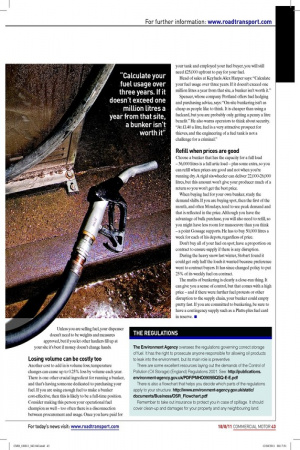Bunker mentality
Page 40

Page 41

If you've noticed an error in this article please click here to report it so we can fix it.
Bunkering your own fuel can make sense for large quantities and long-term planning, but is it always cost-effective?
Words: Louise Cole Having your own fuel bunkers can be an attractive proposition for hauliers using large quantities of fuel fast. On the surface, it gives you control, a ready back-up for back-to-base operations, and a certain level of protection against sudden price luctuations.
However, unlike the UK, mainland Europe and Ireland do not have a tradition of bunkering and there are powerful arguments against it. There is pressure from all quarters of the oil supply world to steer large users away from bunkering, and their motivation is worth some consideration: it is much harder for oil suppliers to make the same kind of margin on bulk purchases they get with commercial or retail fuel cards.
If you’re considering bunkering, then take advice from someone who is supplyand method-neutral.
Let’s start with the costs. Installing a bunker, depending on size, runs into the tens of thousands of pounds. James Spencer, MD of Portland Fuel Price Protection, who recently had some bunkers itted for a client, estimates that even a 25,000-litre bunker will cost in the region of £15,000.
Difficulty keeping the costs down
Paul Gossage, fuel manager at Eddie Stobart, says once you add in all the extra engineering it could be double that price. He’s having a bunker refurbished at a cost of £12,000. “If you needed a new tank as well, you are probably looking at £30,000,” he says.
Return on investment could take between ive and 10 years. Apart from the cost of a tank, you also have to take into account the cost of the pipework, a bund (the high wall used as a secondary barrier), drainage, pumps and hoses, and a reinforced area of the yard that can act as your fuel island.
Then you need to forecast your maintenance costs – they probably won’t be particularly high, but you do need someone with the capacity to oversee maintenance. Biodiesel attracts bacteria, so your tanks will need Redex-type fuel additives; they must be cleaned every two to ive years, pumps need calibrating and the structure and pipework needs checking regularly for any leakage. Your tank will corrode if improperly maintained. Unless you are selling fuel, your dispenser doesn’t need to be weights and measures approved, but if you let other hauliers ill up at your site it’s best if money doesn’t change hands.
Losing volume can be costly too
Another cost to add in is volume loss; temperature changes can cause up to 0.25% loss by volume each year. There is one other crucial ingredient for running a bunker, and that’s having someone dedicated to purchasing your fuel. If you are using enough fuel to make a bunker cost-effective, then this is likely to be a full-time position. Consider making this person your operational fuel champion as well – too often there is a disconnection between procurement and usage. Once you have paid for your tank and employed your fuel buyer, you will still need £25,000 upfront to pay for your fuel.
Head of sales at Keyfuels Alex Harper says: “Calculate your fuel usage over three years. If it doesn’t exceed one million litres a year from that site, a bunker isn’t worth it.” Spencer, whose company Portland offers fuel hedging and purchasing advice, says: “On-site bunkering isn’t as cheap as people like to think. It is cheaper than using a fuelcard, but you are probably only getting a penny a litre beneit.” He also warns operators to think about security. “At £1.40 a litre, fuel is a very attractive prospect for thieves, and the engineering of a fuel tank is not a challenge for a criminal.”
Refill when prices are good
Choose a bunker that has the capacity for a full load – 36,000 litres is a full artic load – plus some extra, so you can reill when prices are good and not when you’re running dry. A rigid six-wheeler can deliver 22,000-26,000 litres, but this amount won’t give your producer much of a return so you won’t get the best price.
When buying fuel for your own bunker, study the demand shifts. If you are buying spot, then the irst of the month, and often Mondays, tend to see peak demand and that is relected in the price. Although you have the advantage of bulk purchase, you will also need to reill, so you might have less room for manoeuvre than you think – a point Gossage supports. He has to buy 50,000 litres a week for each of his depots, regardless of price.
Don’t buy all of your fuel on spot; have a proportion on contract to ensure supply if there is any disruption.
During the heavy snow last winter, Stobart found it could get only half the loads it wanted because preference went to contract buyers. It has since changed policy to put 25% of its weekly fuel on contract.
The maths of bunkering is clearly a close-run thing. It can give you a sense of control, but that comes with a high price – and if there were further fuel protests or other disruption to the supply chain, your bunker could empty pretty fast. If you are committed to bunkering, be sure to have a contingency supply such as a Platts-plus fuel card in reserve. ■

















































